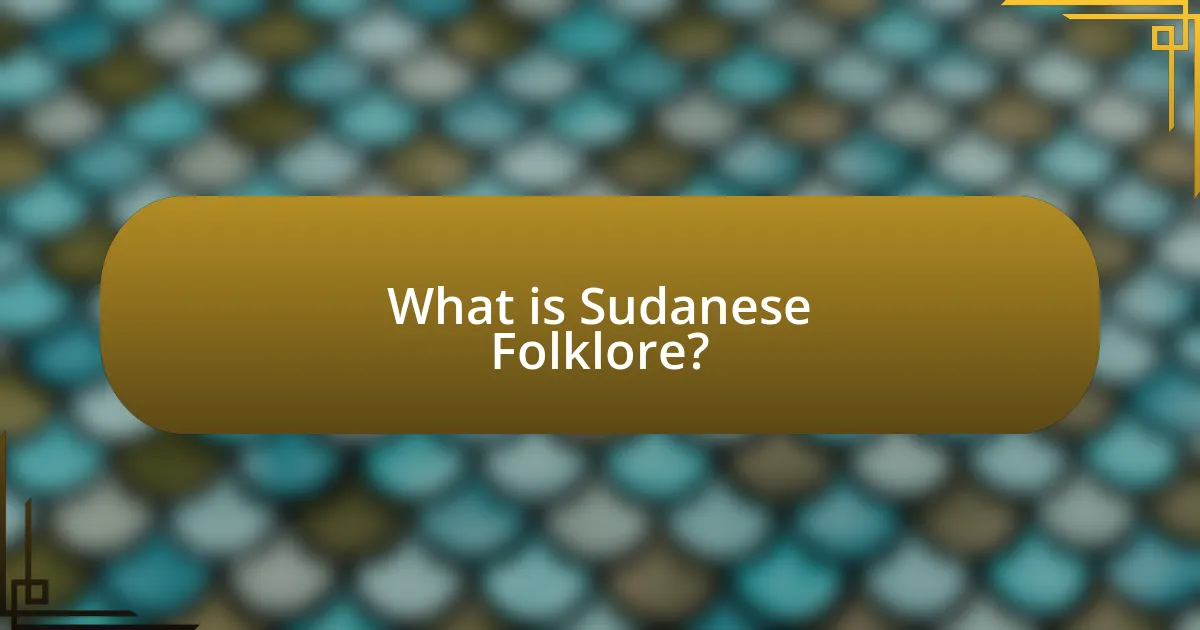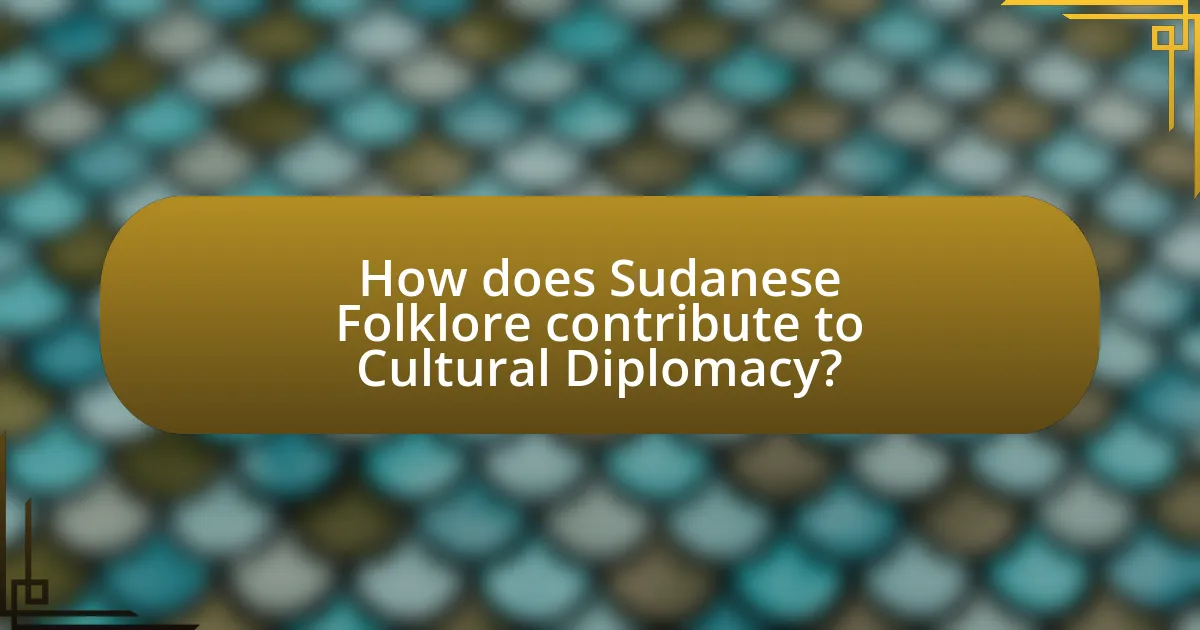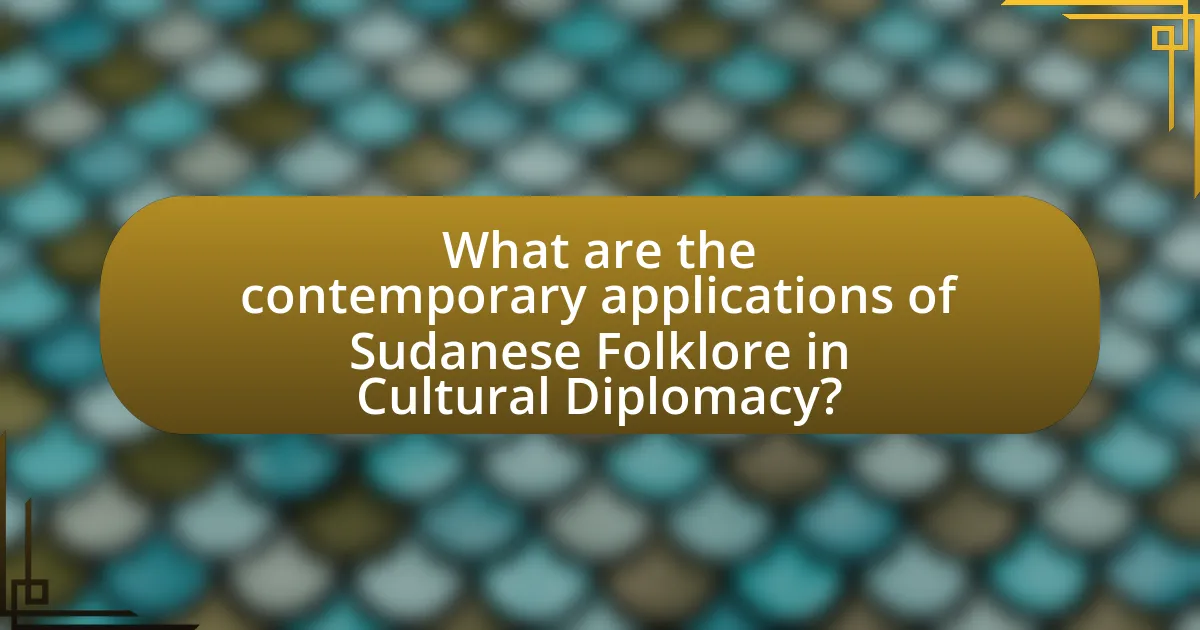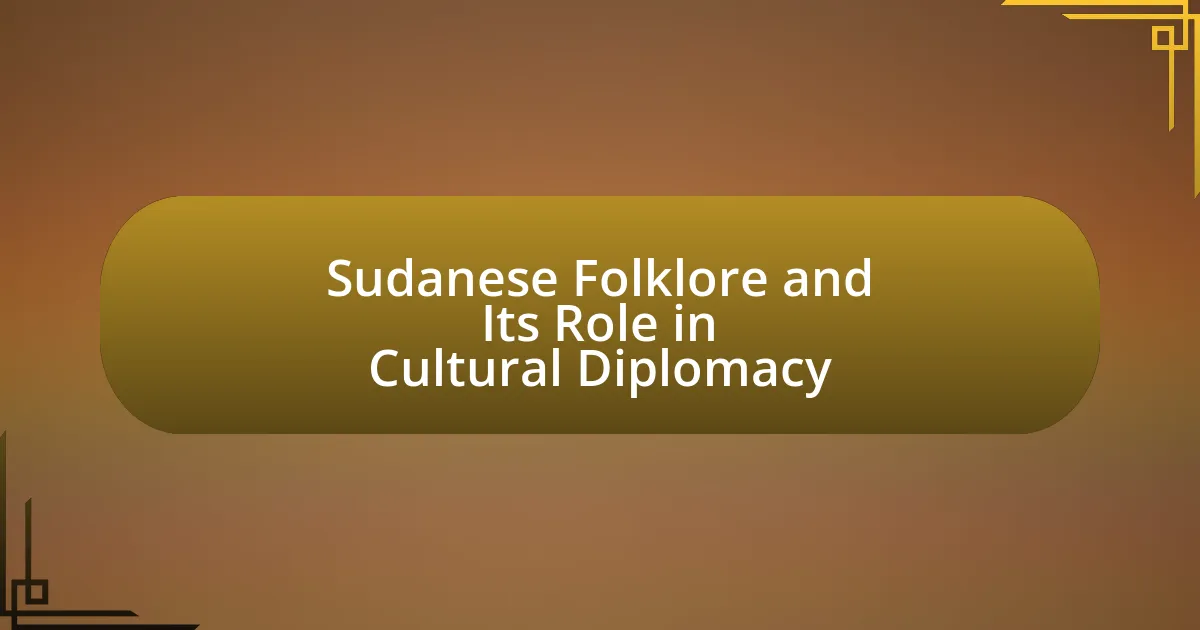Sudanese folklore is a rich tapestry of traditional beliefs, stories, music, and practices that reflect the diverse cultural heritage of Sudan’s ethnic groups. This article explores how Sudanese folklore preserves cultural identity through oral traditions, music, dance, and storytelling, while also serving as a means of fostering community cohesion. Key elements such as proverbs and historical narratives are examined for their role in maintaining cultural continuity and promoting moral values. Additionally, the article discusses the significance of folklore in cultural diplomacy, highlighting its potential to enhance international relationships and improve Sudan’s global image through cultural exchanges and collaborations.

What is Sudanese Folklore?
Sudanese folklore encompasses the traditional beliefs, stories, music, and practices of the diverse ethnic groups in Sudan. It reflects the rich cultural heritage of the country, showcasing narratives that include myths, legends, proverbs, and oral histories passed down through generations. The folklore often serves as a means of preserving cultural identity and fostering community cohesion, with elements such as storytelling, dance, and music playing significant roles in social gatherings and rituals.
How does Sudanese Folklore reflect cultural identity?
Sudanese folklore reflects cultural identity by preserving and transmitting the values, beliefs, and traditions of various ethnic groups within Sudan. This folklore encompasses oral traditions, music, dance, and storytelling, which serve as a means of expressing communal history and social norms. For instance, the tales of the trickster figure, such as the character of “El-Haj,” illustrate moral lessons and cultural values that resonate with Sudanese society. Additionally, traditional music and dance forms, like the “Nuba” dances, are integral to celebrations and rituals, reinforcing a sense of belonging and cultural continuity among communities. These elements collectively contribute to a shared identity that is recognized and celebrated both locally and internationally, highlighting Sudan’s rich cultural heritage.
What are the key elements of Sudanese Folklore?
The key elements of Sudanese folklore include oral traditions, music, dance, storytelling, and proverbs. Oral traditions serve as a primary means of preserving history and cultural identity, often passed down through generations. Music and dance are integral to celebrations and rituals, reflecting the diverse ethnic groups within Sudan. Storytelling, featuring tales of heroes and moral lessons, plays a crucial role in community bonding and education. Proverbs encapsulate wisdom and cultural values, often used in daily conversation to convey deeper meanings. These elements collectively contribute to the rich tapestry of Sudanese cultural heritage and its expression in cultural diplomacy.
How do oral traditions play a role in Sudanese Folklore?
Oral traditions are fundamental to Sudanese folklore as they serve as the primary means of preserving and transmitting cultural narratives, values, and history. These traditions encompass storytelling, proverbs, songs, and rituals that reflect the diverse ethnic groups within Sudan, such as the Nubians, Beja, and Fur. For instance, the epic tales of the Sudanese hero, Sayed Abdel Rahman, illustrate moral lessons and historical events, reinforcing community identity and cohesion. Furthermore, oral traditions facilitate intergenerational knowledge transfer, ensuring that cultural heritage is maintained despite external influences and modernization. This role is evidenced by the continued practice of storytelling in communal gatherings, which not only entertains but also educates younger generations about their cultural roots and social responsibilities.
Why is Sudanese Folklore important in understanding Sudanese culture?
Sudanese folklore is crucial for understanding Sudanese culture because it encapsulates the beliefs, values, and traditions that shape the identity of the Sudanese people. This folklore includes oral narratives, music, dance, and rituals that have been passed down through generations, reflecting the historical experiences and social norms of various ethnic groups within Sudan. For instance, the tales of the trickster figure, such as the character of “El-Haj,” illustrate moral lessons and societal expectations, providing insight into the community’s collective consciousness. Additionally, folklore serves as a means of preserving cultural heritage, fostering a sense of belonging, and promoting unity among diverse groups in Sudan, which is essential for cultural diplomacy efforts aimed at enhancing national identity and social cohesion.
What themes are commonly found in Sudanese Folklore?
Common themes found in Sudanese folklore include the celebration of community, the importance of oral tradition, and the interplay between morality and justice. These themes reflect the social values and cultural identity of Sudanese society. For instance, stories often emphasize communal bonds and collective responsibility, showcasing how individuals contribute to the well-being of their communities. Additionally, oral traditions serve as a means of preserving history and passing down knowledge, highlighting the significance of storytelling in Sudanese culture. Morality and justice are frequently explored through narratives that illustrate the consequences of actions, reinforcing ethical behavior within the community.
How does folklore preserve historical narratives in Sudan?
Folklore preserves historical narratives in Sudan by transmitting cultural stories, traditions, and values through oral traditions and performances. This oral transmission allows for the retention of historical events, social norms, and collective memories that might otherwise be lost. For instance, tales of historical figures and significant events, such as the resistance against colonialism, are recounted in songs, proverbs, and storytelling, ensuring that these narratives remain alive in the community’s consciousness. Additionally, folklore serves as a means of identity formation, linking contemporary Sudanese people to their ancestral past and reinforcing a sense of belonging and continuity within the cultural landscape.

How does Sudanese Folklore contribute to Cultural Diplomacy?
Sudanese folklore contributes to cultural diplomacy by fostering mutual understanding and appreciation among diverse cultures through its rich traditions, stories, and artistic expressions. The narratives and performances rooted in Sudanese folklore, such as oral storytelling and traditional music, serve as cultural ambassadors that showcase Sudan’s heritage and values. For instance, events like the Sudanese Folklore Festival promote cultural exchange and dialogue, allowing international audiences to engage with Sudanese identity. This engagement can lead to strengthened diplomatic relations, as shared cultural experiences often bridge gaps between nations and enhance collaborative efforts in various fields, including education and tourism.
What role does folklore play in international cultural exchanges?
Folklore plays a crucial role in international cultural exchanges by serving as a medium for sharing traditions, values, and narratives that foster mutual understanding among diverse cultures. Through storytelling, music, dance, and rituals, folklore enables communities to express their identities and heritage, facilitating dialogue and connection across borders. For instance, Sudanese folklore, rich in oral traditions and cultural practices, has been instrumental in cultural diplomacy efforts, showcasing Sudan’s unique heritage at international festivals and events, thereby promoting cultural appreciation and collaboration. This exchange not only enhances cultural visibility but also strengthens diplomatic ties by creating a platform for intercultural dialogue and respect.
How can Sudanese Folklore be used to foster understanding between cultures?
Sudanese folklore can foster understanding between cultures by serving as a medium for storytelling that highlights shared human experiences and values. Through traditional tales, music, and dance, Sudanese folklore conveys themes of community, resilience, and morality, which resonate across diverse cultural backgrounds. For instance, the oral traditions of Sudan often include narratives that emphasize hospitality and kinship, values that are universally appreciated. By engaging with these stories, individuals from different cultures can find common ground, facilitating dialogue and mutual respect. Additionally, cultural exchanges that incorporate Sudanese folklore, such as festivals or workshops, allow participants to experience and appreciate the richness of Sudanese heritage, further bridging cultural divides.
What examples exist of Sudanese Folklore being showcased abroad?
Sudanese folklore has been showcased abroad through various cultural events and festivals. For instance, the Sudanese National Dance Troupe has performed internationally, highlighting traditional dances such as the “Hawiya” and “Dabke” at events like the International Festival of Arts in Cairo and the World Festival of Youth and Students in Sochi. Additionally, Sudanese storytelling and music have been featured in cultural exchange programs in Europe and North America, promoting Sudanese heritage and fostering cross-cultural dialogue. These performances not only celebrate Sudanese traditions but also serve as a means of cultural diplomacy, enhancing Sudan’s international presence.
Why is Cultural Diplomacy significant for Sudan?
Cultural diplomacy is significant for Sudan because it fosters international relationships and enhances the country’s global image through the promotion of its rich cultural heritage. By showcasing Sudanese folklore, art, and traditions, cultural diplomacy helps to counter negative stereotypes and build mutual understanding with other nations. For instance, Sudan’s diverse cultural expressions, such as traditional music and dance, serve as tools for dialogue and collaboration, facilitating partnerships in areas like education and tourism. This approach not only strengthens Sudan’s cultural identity but also contributes to economic development by attracting cultural tourism and investment.
How does Cultural Diplomacy impact Sudan’s global image?
Cultural diplomacy significantly enhances Sudan’s global image by showcasing its rich heritage and diverse traditions. Through initiatives such as cultural exchanges, art exhibitions, and international festivals, Sudan presents its folklore, music, and crafts to a global audience, fostering a positive perception. For instance, Sudan’s participation in the UNESCO Creative Cities of Music initiative highlights its commitment to cultural preservation and innovation, which can counteract negative stereotypes and promote a more nuanced understanding of the country. This strategic use of cultural diplomacy not only builds international relationships but also attracts tourism and investment, further solidifying Sudan’s standing on the world stage.
What are the challenges faced in promoting Sudanese Folklore internationally?
Promoting Sudanese folklore internationally faces several challenges, including limited global awareness, cultural misinterpretation, and political instability. Limited global awareness stems from insufficient representation in international cultural events and media, which restricts exposure to Sudanese traditions. Cultural misinterpretation occurs when foreign audiences lack context or familiarity with Sudanese customs, leading to misunderstandings. Political instability in Sudan further complicates promotion efforts, as ongoing conflicts can hinder cultural exchanges and collaborations. These factors collectively impede the effective dissemination and appreciation of Sudanese folklore on a global scale.

What are the contemporary applications of Sudanese Folklore in Cultural Diplomacy?
Contemporary applications of Sudanese folklore in cultural diplomacy include the promotion of national identity, fostering international relationships, and enhancing tourism. Sudanese folklore, characterized by traditional music, dance, storytelling, and art, serves as a medium to showcase the country’s rich cultural heritage at international events, such as cultural festivals and exhibitions. For instance, the Sudanese government has utilized folklore performances to engage with foreign audiences, thereby strengthening diplomatic ties and promoting cultural exchange. Additionally, folklore is integrated into educational programs and workshops aimed at raising awareness about Sudan’s cultural diversity, which can attract tourists and enhance the country’s image abroad. These applications demonstrate how Sudanese folklore plays a vital role in cultural diplomacy by facilitating dialogue and understanding between nations.
How is Sudanese Folklore integrated into modern diplomatic efforts?
Sudanese folklore is integrated into modern diplomatic efforts by utilizing cultural narratives and traditional practices to foster mutual understanding and strengthen international relations. This integration occurs through cultural exchange programs, where folklore is showcased in art, music, and storytelling, promoting Sudan’s rich heritage and enhancing its soft power. For instance, Sudanese traditional music and dance have been featured in international festivals, allowing diplomats to engage with foreign audiences and create a positive image of Sudan. Additionally, folklore serves as a tool for dialogue, enabling discussions around shared values and cultural similarities, which can lead to collaborative initiatives and partnerships.
What initiatives exist to promote Sudanese Folklore globally?
Various initiatives exist to promote Sudanese folklore globally, including cultural festivals, academic collaborations, and digital platforms. For instance, the Sudanese Cultural Center in Paris organizes events that showcase traditional music, dance, and storytelling, fostering international appreciation. Additionally, partnerships between Sudanese universities and foreign institutions facilitate research and exchange programs focused on folklore studies. Digital platforms, such as social media campaigns and online archives, also play a crucial role in disseminating Sudanese folklore to a wider audience, allowing for greater visibility and engagement. These initiatives collectively enhance the global understanding and appreciation of Sudanese cultural heritage.
How do artists and cultural ambassadors utilize folklore in their work?
Artists and cultural ambassadors utilize folklore in their work by incorporating traditional stories, music, and visual arts to express cultural identity and promote understanding. For instance, Sudanese artists often draw on local myths and legends to create artworks that reflect the values and history of their communities, fostering a sense of pride and continuity. Cultural ambassadors leverage these elements in diplomatic contexts to bridge cultural gaps, using folklore as a tool for dialogue and connection. This approach is supported by the fact that folklore serves as a repository of collective memory, enabling artists to convey complex cultural narratives that resonate with diverse audiences, thereby enhancing cultural diplomacy efforts.
What best practices can enhance the role of Sudanese Folklore in Cultural Diplomacy?
Integrating Sudanese folklore into cultural diplomacy can be enhanced by promoting authentic storytelling, engaging local artists, and fostering international collaborations. Authentic storytelling allows for the genuine representation of Sudanese culture, which can resonate with diverse audiences and create emotional connections. Engaging local artists ensures that the folklore is presented in a culturally relevant manner, preserving its integrity while showcasing its richness. Additionally, fostering international collaborations, such as cultural exchange programs and joint performances, can amplify the reach of Sudanese folklore, allowing it to be appreciated globally. These practices not only elevate Sudanese cultural heritage but also strengthen diplomatic ties through shared cultural experiences.
How can collaboration with international organizations improve folklore promotion?
Collaboration with international organizations can significantly enhance folklore promotion by providing access to broader platforms and resources for cultural exchange. Such partnerships enable the sharing of Sudanese folklore with global audiences, increasing visibility and appreciation. For instance, organizations like UNESCO actively support the safeguarding of intangible cultural heritage, which includes folklore, through initiatives that promote cultural diversity and intercultural dialogue. This collaboration can lead to funding opportunities, workshops, and festivals that showcase Sudanese traditions, thereby fostering greater understanding and respect for the culture on an international scale.
What strategies can be employed to engage younger generations with folklore?
To engage younger generations with folklore, interactive digital platforms can be utilized to create immersive experiences. These platforms, such as mobile apps and social media, allow for storytelling through multimedia formats like videos, animations, and games, making folklore more accessible and appealing. For instance, the use of augmented reality in storytelling can bring traditional tales to life, fostering a deeper connection with cultural narratives. Research indicates that younger audiences are more likely to engage with content that is visually stimulating and interactive, as evidenced by studies showing increased retention and interest in educational materials presented in these formats.

Leave a Reply